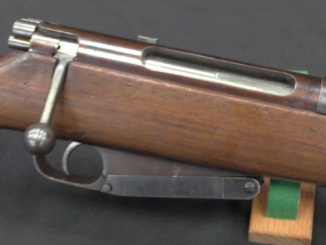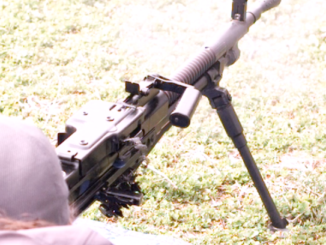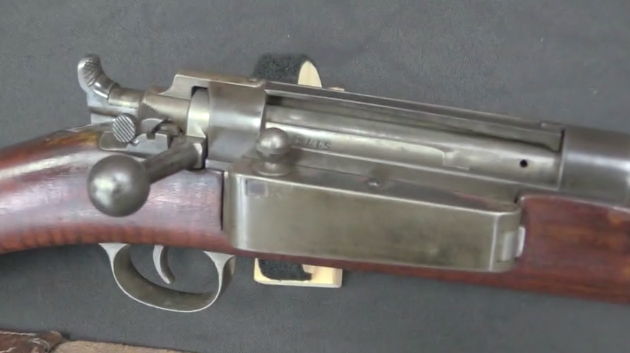The Maden-Saetter was the Madsen (DISA) company’s entry into the GPMG arena. It Wass developed by Eric Larsen-Saetter in the early 1950s, although it did not enter production until 1960. The design was heavily German-influenced, with an MG34-like receiver, MG42-like recoil mechanism and feed system, and G43-like locking system. Unfortunately for DISA, it was a bit too complicated and had to compete against some truly excellent GPMG alternative at the time; the FN MAG and MG42/59 (aka MG3). A total of just 11,500 were produced, and the only significant military contract was to the Indonesian Army.
Related Articles

Bolt Action Rifles
Schultz & Larsen RPLT-42: Danish Occupation Rifle
When the Danish Coastal Police was formed under German occupation to patrol the Danish shores, they needed rifles. Rather than use valuable military arms, the government turned to the noted sporting and target rifle manufacturer […]

General Purpose MGs
Danish Madsen-Saetter GPMG at the Range
The Madsen-Saetter is a general purpose machine gun that had the unfortunate luck to compete against the MG42/MG3 and FN MAG. It is a quite nice gun to shoot, but not quite up to the […]

Bolt Action Rifles
RIA: Danish 1889 Krag-Jorgensen Rifle
The Danes were the first military to adopt the Krag-Jorgensen rifle, with this infantry variant in 1889. It is chambered for the Danish 8x58R cartridge, which was also used in Remington Rolling Block rifles (although […]

“Madsen was best known for making submachine guns” Uhhh, wasn’t there something called THE Madsen gun?
In terms of the GPMG, the PK was mentioned and the MAG ignored?
In early Cold War Madsen managed to sell m/46 or derivatives https://modernfirearms.net/en/submachine-guns/denmark-submachine-guns/madsen-m46-m50-m53-eng/ to various Asian and South American countries
It did also spawned 11,43 mm version namely INA M/953 https://modernfirearms.net/en/submachine-guns/brazil-submachine-guns/ina-mb-50-m-953-2/
In the inter-World War period, Madsen managed to market the Madsen LMG to Argentina, Brazil, Bolivia, Chile, El Salvador and Honduras, Ethiopia (invaded and occupied by Italy after 1935-36), Mexico, Norway, the Netherlands, Paraguay, Peru, Portugal, Turkey and Uruguay.
In the early Cold War-era, when the Madsen was rather long in the tooth, it was still being sold and marketed to Brazil, El Salvador, Indonesia, and Portugal.
Of course, there is footage of ongoing gang wars in Brazilian favelas from the 21st century where members of the BOPE–the special forces of the military police of Rio de Janeiro–took out some ancient Madsen in 7mm Mauser or .30-06 still in the armory of the PM and were photographed using it in one or another megaslum.
Those Madsem LMGs have actually been converted to shoot 7,62*51 mm long ago. And yes, they are still in use as support weapons in street gunfights there.
Daweo, Yes, I am quite aware of the Madsen SMG’s, but the firm’s fame came from the LMG
Speaking of “locking recesses hardened separately’ what Rockwell hardness do you need for locking lugs?
… extractors?
… ejectors?
… firing pins?
… chambers?
… barrel bores?
“(…)heavily German-influenced(…)”
Does this also apply to safety, so S means Sicher and F means Feuer xor these are denoting words in Bahasa Indonesia?
I vote for S meaning SAFE and F meaning FIRE, considering the Danes had export in mind.
“(…)developed by Eric Larsen-Saetter in the early 1950s, although it did not enter production until 1960(…)”
https://www.smallarmsreview.com/display.article.cfm?idarticles=3600 claims that
(…)In the 1950’s an early version of this gun, the Mark I, was tested in England by the British army for possible adoption. The more expensive but very reliable FN MAG succeeded in beating out all other competitors, including the Madsen. All this came a little too late because the lion’s share of international sales had now gone to the FN MAG or the West German 42-59.(…) main reason that the system didn’t compete in the world market more favorably was the fact that the gun wasn’t fully developed for trails until the third model or the Mark III. Unfortunately when the British rested the Mark I at their trails, they found it unreliable. This hurt the marketability throughout the world.(…)
Regarding bi-pod it says that it was changed from steel to aluminum as one of changes applied developing Mark III.
https://modernfirearms.net/en/machineguns/denmark-machineguns/madsen-saetter-eng/ does mention bigger version A brief attempt was made during the early 1960s to produce a 12.7mm heavy machine gun based on the same Saetter design, but it never wentinto mass production.
Does anybody know size, mass, Rate-of-Fire of 12,7 mm version of this fire-arm?
Looks like a good design with neat features if a bit complicated. They should have used the time between design and actual start of manufacture to iterate and simplify the design imho. Maybe they could have taken some NATO contracts that otherwise have been taken by either FN MAG or the various MG42 derivatives.
This is why I love forgotten weapons, I’ve learned and seen stuff I didn’t even know it existed,Thanks Ian
This is a hodge-podge design containing idiosyncrasies such as expanding bits falling into MACHINED steel receiver – completely off mark. The feed mechanism is outright awkward – way too fancy for what it needs to be. Gas regulator operation is a clear miss – practically useless. On the other hand there are some plausible features such as bipod connected to receiver. Trigger mechanism – not bad. On balance I do not see area where it would bring something radically new or remarkable.
Little bit fussy, little bit complicated, but I like what I see in terms of “crew interface”. The people who designed this at least had a slight clue about how MG teams conduct business under fire.